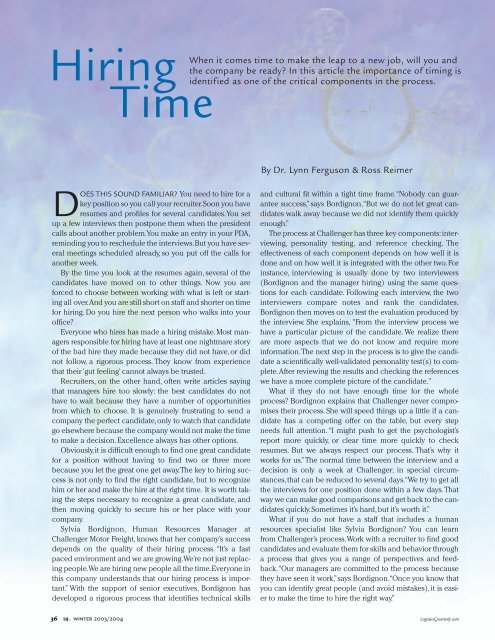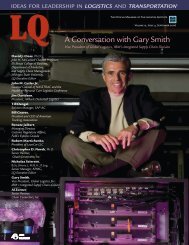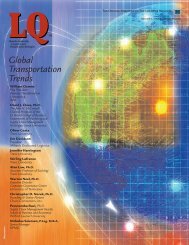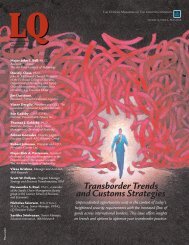Reverse Logistics - Logistics Quarterly
Reverse Logistics - Logistics Quarterly
Reverse Logistics - Logistics Quarterly
Create successful ePaper yourself
Turn your PDF publications into a flip-book with our unique Google optimized e-Paper software.
Hiring<br />
Time<br />
DOES THIS SOUND FAMILIAR? You need to hire for a<br />
key position so you call your recruiter.Soon you have<br />
resumes and profiles for several candidates.You set<br />
up a few interviews then postpone them when the president<br />
calls about another problem.You make an entry in your PDA,<br />
reminding you to reschedule the interviews.But you have several<br />
meetings scheduled already, so you put off the calls for<br />
another week.<br />
By the time you look at the resumes again, several of the<br />
candidates have moved on to other things. Now you are<br />
forced to choose between working with what is left or starting<br />
all over.And you are still short on staff and shorter on time<br />
for hiring. Do you hire the next person who walks into your<br />
office?<br />
Everyone who hires has made a hiring mistake. Most managers<br />
responsible for hiring have at least one nightmare story<br />
of the bad hire they made because they did not have, or did<br />
not follow, a rigorous process. They know from experience<br />
that their ‘gut feeling’ cannot always be trusted.<br />
Recruiters, on the other hand, often write articles saying<br />
that managers hire too slowly: the best candidates do not<br />
have to wait because they have a number of opportunities<br />
from which to choose. It is genuinely frustrating to send a<br />
company the perfect candidate,only to watch that candidate<br />
go elsewhere because the company would not make the time<br />
to make a decision. Excellence always has other options.<br />
Obviously,it is difficult enough to find one great candidate<br />
for a position without having to find two or three more<br />
because you let the great one get away.The key to hiring success<br />
is not only to find the right candidate, but to recognize<br />
him or her and make the hire at the right time. It is worth taking<br />
the steps necessary to recognize a great candidate, and<br />
then moving quickly to secure his or her place with your<br />
company.<br />
Sylvia Bordignon, Human Resources Manager at<br />
Challenger Motor Freight, knows that her company’s success<br />
depends on the quality of their hiring process. “It’s a fast<br />
paced environment and we are growing.We’re not just replacing<br />
people.We are hiring new people all the time.Everyone in<br />
this company understands that our hiring process is important.”<br />
With the support of senior executives, Bordignon has<br />
developed a rigorous process that identifies technical skills<br />
36 LQ winter 2003/2004<br />
When it comes time to make the leap to a new job, will you and<br />
the company be ready? In this article the importance of timing is<br />
identified as one of the critical components in the process.<br />
By Dr. Lynn Ferguson & Ross Reimer<br />
and cultural fit within a tight time frame.“Nobody can guarantee<br />
success,” says Bordignon,“But we do not let great candidates<br />
walk away because we did not identify them quickly<br />
enough.”<br />
The process at Challenger has three key components:interviewing,<br />
personality testing, and reference checking. The<br />
effectiveness of each component depends on how well it is<br />
done and on how well it is integrated with the other two. For<br />
instance, interviewing is usually done by two interviewers<br />
(Bordignon and the manager hiring) using the same questions<br />
for each candidate. Following each interview, the two<br />
interviewers compare notes and rank the candidates.<br />
Bordignon then moves on to test the evaluation produced by<br />
the interview. She explains, "From the interview process we<br />
have a particular picture of the candidate. We realize there<br />
are more aspects that we do not know and require more<br />
information.The next step in the process is to give the candidate<br />
a scientifically well-validated personality test(s) to complete.After<br />
reviewing the results and checking the references<br />
we have a more complete picture of the candidate."<br />
What if they do not have enough time for the whole<br />
process? Bordignon explains that Challenger never compromises<br />
their process. She will speed things up a little if a candidate<br />
has a competing offer on the table, but every step<br />
needs full attention.“I might push to get the psychologist’s<br />
report more quickly, or clear time more quickly to check<br />
resumes. But we always respect our process. That’s why it<br />
works for us.”The normal time between the interview and a<br />
decision is only a week at Challenger; in special circumstances,that<br />
can be reduced to several days.“We try to get all<br />
the interviews for one position done within a few days.That<br />
way we can make good comparisons and get back to the candidates<br />
quickly. Sometimes it’s hard, but it’s worth it.”<br />
What if you do not have a staff that includes a human<br />
resources specialist like Sylvia Bordignon? You can learn<br />
from Challenger’s process.Work with a recruiter to find good<br />
candidates and evaluate them for skills and behavior through<br />
a process that gives you a range of perspectives and feedback.“Our<br />
managers are committed to the process because<br />
they have seen it work,”says Bordignon.“Once you know that<br />
you can identify great people (and avoid mistakes), it is easier<br />
to make the time to hire the right way.”<br />
<strong>Logistics</strong><strong>Quarterly</strong>.com







